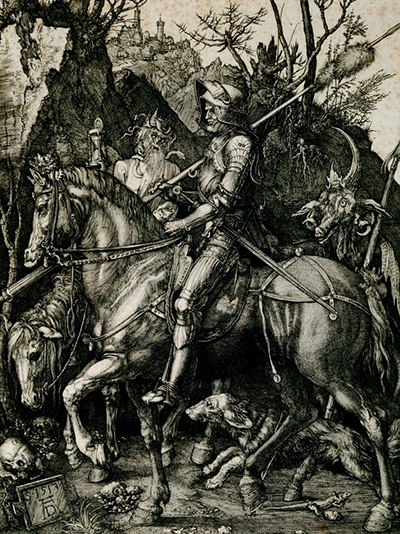Knight, Death and the Devil, published in 1513, is a copper engraving produced by Albrecht Dürer at his Nüremburg workshop during the reign of Emperor Maximilian I.
The engraving, created during a period in the German artist's career when his main focus was on copper plate printmaking, is considered by some art historians to belong to a trilogy known as the Master Engravings and contains similar themes to those found in some of his other creations.
This work is considered to be one of the foremost artistic offerings of the Northern Renaissance, of which Dürer was a major proponent, and the true meaning of the engraving has been a point of contention since its publication.
Possible inspirations for the dramatic scene include Psalm 23 and Handbook of a Christian Knight by Desiderius Erasmus.
The engraving depicts a procession of earthly and supernatural beings travelling along a mountain pass from the right-hand-side of the frame to the left while the high-gabled roofs, crenellated walls and lofty towers of a citadel are visible in the distance. A horseman, wearing plate-armour and resting a lance on his shoulder, is riding a powerful charger in the company of two monstrous figures that are considered to be manifestations of Death and the Devil.
The rider's visor is lifted, displaying a shaven face that is fixed in a stoical expression, while an animal pelt is tied below the tip of his lance. A medium-sized and shaggy-coated hound, its ears dropped and rearward-facing, runs between the mounted figures of death and the knight while a lizard crawls in the opposite direction of the procession amidst the falling hooves.
Death, riding a horse and flanking the mounted knight, turns his head towards the rider and holds an hourglass in his left hand. His skull is visible beneath the decomposing flesh of his face, still displaying a beard, while a snake winds its way through the spikes of his crown and another coils around his shoulders. The hourglass, also featured in Dürer's Melancholia I and Young Couple Threatened by Death, may represent the amount of time the knight has left on earth.
A sundial, mounted on top of the hourglass, casts its shadow on five while the volume of sand in the upper-half of the hourglass suggests that the rider has already spent half of his allotted time on earth. Death's horse, its left ear pointing up and its right ear level, lowers its head and looks towards a human skull that sits on top of a tree stump.
A tablet, resting against the tree stump on top of which the skull is positioned, is located at the bottom-left-hand corner of the print and displays the year of the engraving's creation as well as the artist's initials. The skull, lacking a jawbone, is facing towards the right-hand-side of the print which gives the impression that its lifeless form is looking towards the approaching party.
While Dürer, who studied human anatomy alongside other scientific disciplines, may have been fascinated by skulls for aesthetic reasons he would have been aware of their symbolic power in the Holy Roman Empire and throughout the rest of Europe. Skulls, inanimate and revealed via the process of decay, are emblematic of human mortality and were often depicted on gravestones as a reminder to the living that their days on earth are numbered.
The Devil, a dismounted figure carrying a pole-weapon against its right shoulder, follows the rider and appears to outstretch its arm to reveal a clawed hand that is partially hidden behind the mounted knight's back. Pole-arms, like that brandished by the diabolical figure in the engraving, revolutionised warfare in the Renaissance-era by allowing part-time and semi-professional militias to destroy elite detachments of mounted warriors. The War of the League of Cambria, in which the Holy Roman Empire participated on both sides, was occurring at the time that Dürer made the engraving and the military theme in the print may have reflected that. The infernal entity, its lower body obscured by the hind-quarters of the rider's mount, is a b@stial figure with a chimeric appearance that includes a ram's horns and a porcine muzzle.




